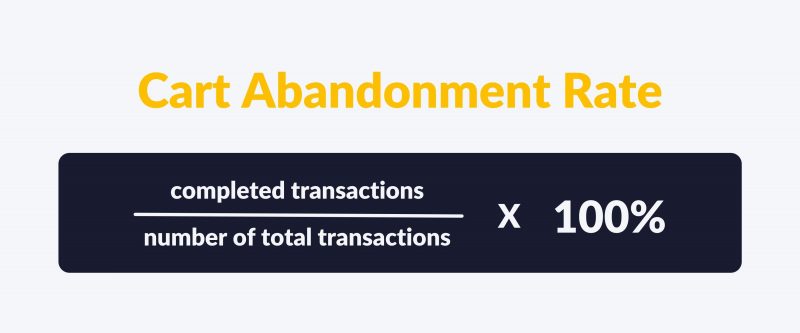In contrast to regular shops, in e-commerce “cart abandonment” is a common practice. So it’s worth tracking Cart Abandonment Rate to try to understand and solve the reasons related to this phenomenon.
Cart Abandonment Rate – table of contents:
- What is the Cart Abandonment Rate?
- Reasons for unpaid shopping carts
- Reasons why customers abandon their shopping carts
- How to recover abandoned shopping carts?
What is the Cart Abandonment Rate?
An abandoned cart is a situation when a user visits an online store, adds products to the cart, but does not complete the shopping process because he or she decides to leave the site.
The shopping cart abandonment rate is calculated according to the formula:

Online store owners can use Google Analytics reports where they can find information about the value of the shopping cart abandonment rate within their history to on their site.
Reasons for unpaid shopping carts
Why do customers leave their shopping carts unpaid? The main reasons are:
- customers checking their account/budget balance
- looking for more information about a product
- looking for possible discounts/discounts
- consulting the purchase with another person
- postponing the final purchase
The owner of an online store must also remember that not every Internet user visiting their site comes intending to make a purchase. Often such people just want to check what’s new and what’s on promotion, compare the price with a competitive store or simply get inspired.

Reasons why customers abandon their shopping carts
Why do customers abandon their shopping carts? The most important reasons include:
- Lack of preferred payment method – every customer has their preference on how to pay for purchases. So you should prepare as many options as possible to choose from. It is also worth betting on such solutions which will be fast so that the client can complete the purchase regardless of where he is and how much time he has at his disposal.
- Paid product returns and high delivery costs – sellers are not always able to negotiate a better deal with carriers. However, they can check alternative options from time to time to find the cheapest one. Also, like the previous point, it’s a good idea to take care of different delivery methods to provide customers with choices.
- Not being able to check the total cost of the order before finalizing it – customers prefer to have clear and transparent information about the cost and what they have to pay for. It is not worth hiding additional costs, as displaying them just before the purchase is finalized may discourage buyers. It’s best to include information about additional costs already at the product card stage.
- Too complicated purchase process – long and complicated purchase process can effectively discourage customers from completing the purchase. Buyers do not like wasting time on too time-consuming activities. Many stores are starting to move away from the multi-step process that required going to more tabs for this reason. Instead, the so-called one-pagers checkout is being used, which means placing all the steps on one page of the website. This enables the customer to make changes at any time without having to go to another page.
What other reasons influence shopping cart abandonment?
- finding a product at a cheaper price in a competitor’s store
- unclear and complicated return policy
- lack of reviews about the store/products
- lack of possibility to contact store staff
- too long delivery time
- poor quality product photos
- lack of possibility to search products quickly
- slow page loading
- vague product descriptions
- unpleasant to use the website
- the need to create an account to place an order
- store not adjusted to mobile devices
How to recover abandoned shopping carts?
Consumers often return to a store’s website on their own in order to complete a purchase. However, they may be discouraged by the fact that the shopping cart has been emptied. Having to search for products from scratch can cause frustration among customers. The time for which stores should keep the user’s shopping cart active depends on the industry. In categories such as electronics, customers frequently need a longer period to make a final purchase decision.
Another way to recover abandoned shopping carts are notifications sent to customers. The effectiveness of such actions is estimated at around 40% and does not depend on the industry and category. The most expected form of notification by consumers is emails. Other solutions are SMS messages, in-app notifications, phone notifications, on the store’s website and social media.
Convincing the consumer to return to the store’s website and complete the transaction can be done by using incentives. According to statistics, the most expected form is receiving a free product. Other incentives can be: free or faster delivery, free return, discount or rebate on the current or next order and the possibility of deferred payment.
Read other articles about ecommerce analytics:
- E-commerce analytics – why it’s important?
- What is Bounce Rate – 7 Ways to Improve
- SWOT analysis of online stores
If you like our content, join our busy bees community on Facebook and Twitter.
Author: Andy Nichols
A problem solver with 5 different degrees and endless reserves of motivation. This makes him a perfect Business Owner & Manager. When searching for employees and partners, openness and curiosity of the world are qualities he values the most.
The most important questions
-
What is Cart Abandonment Rate?
Cart Abandonment Rate is when a user visits an online store's website, adds a product to the cart but leaves the site without completing the transaction.
-
How to calculate the Cart Abandonment Rate?
You can calculate Cart Abandonment Rate by dividing the number of completed transactions by the number of all transactions. The result is then multiplied by 100%.
-
What are the causes of shopping cart abandonment?
The most common causes of shopping cart abandonment are: the lack of a preferred payment method, paid product return and high delivery costs, inability to check the total cost of an order and too complicated shopping process.


















